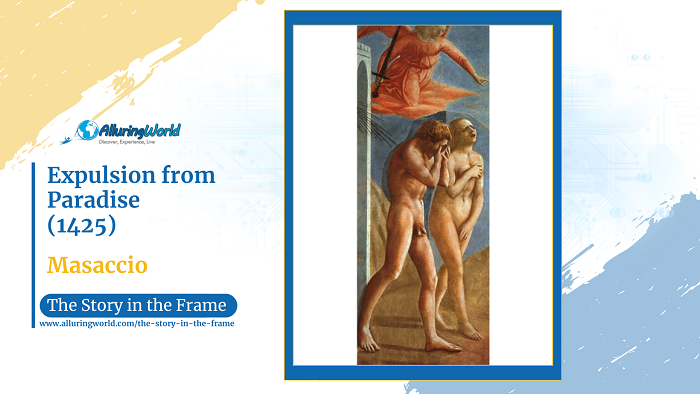Expulsion from Paradise, most commonly referred to and known as Expulsion from the Garden of Eden, that was painted around 1425–1427 is one of the most emotionally powerful frescoes that can be seen from the Italian Renaissance period. As the painting is created by Masaccio for the Brancacci Chapel in Florence, this work captures the biblical moment when Adam and Eve are cast out of the Garden of Eden after their fall from grace, and Masaccio’s innovative use of perspective, naturalistic figures, and emotional depth marked a turning point in Western art, influencing countless artists in the centuries that followed.
About the Painter:
Masaccio (1401–1428) was one of the most influential early Renaissance painters, known for his mastery of perspective, light, and three-dimensional form. Despite his short life, he revolutionized painting by moving away from the flat, decorative style of the Gothic tradition and embracing realism and human emotion, and his work, particularly in the Brancacci Chapel, set the foundation for later Renaissance masters such as Leonardo da Vinci, Michelangelo, and Raphael. Masaccio’s ability to depict the human figure with depth and weight made him one of the most important figures in the transition from medieval to modern painting.
Inspiration and Reasons Behind the Painting:
The Expulsion from Paradise was inspired by the biblical story in Genesis 3:23-24, where Adam and Eve are forced to leave the Garden of Eden after disobeying God, and this theme was commonly depicted in religious art, serving as a reminder of humanity’s fall and the consequences of sin. However, Masaccio’s version stands out for its emotional intensity and dramatic realism, so instead of focusing on decorative elements, he presents Adam and Eve in raw despair, emphasizing their shame and suffering. This approach reflects the humanist ideals of the Renaissance, which sought to depict biblical figures with greater psychological depth and realism.
What is Depicted in the Painting:
The fresco portrays Adam and Eve walking out of the Garden of Eden, their bodies contorted with grief and shame, and while Adam covers his face with his hands, symbolizing despair, Eve wails openly, with her mouth wide in a cry of anguish, and they are guided by an angel, whose outstretched sword signals their banishment. The background is minimal, with only an arched gateway marking the exit from paradise. Unlike earlier medieval depictions, where Adam and Eve appeared passive or stylized, Masaccio’s figures are deeply human, their suffering palpable and immediate, with the composition being simple but powerful, drawing the viewer’s attention directly to the raw emotion of the scene.
Colors and Techniques:
Masaccio’s use of color and shading enhances the realism of the fresco. He employs a naturalistic palette with warm skin tones and soft shadows, giving the figures a sculptural quality, and as the angel is bathed in a supernatural light, contrasting with the darker tones of Adam and Eve, symbolizing their fall into suffering, Masaccio’s mastery of chiaroscuro (the use of light and shadow) creates depth and volume, making the figures appear more lifelike. He additionally employs linear perspective in the archway, reinforcing the sense of space and movement, and his groundbreaking technique in anatomical accuracy and emotional expression set a new standard for Renaissance art.
Conclusion:
Overall, Expulsion from Paradise remains one of the most striking depictions of human sorrow in Western art. Masaccio’s ability to capture raw emotion and physical realism helped redefine religious painting, influencing generations of artists, including Michelangelo, who later praised his work. The fresco’s emphasis on human suffering and psychological depth reflects the broader Renaissance interest in depicting biblical stories with greater authenticity and emotional power. Even today, Expulsion from Paradise continues to resonate with audiences, reminding us of the fragility of innocence and the weight of consequence.

